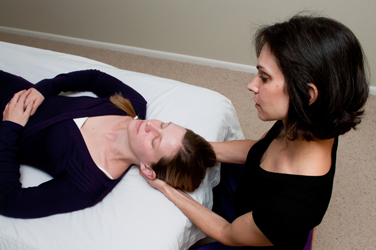

Most of us have had the experience of receiving a massage where the intention has been to manipulate the muscle tissue into relaxation, with the hope that once the musculature relaxes the mind and nervous system follow. As a massage practitioner for over two decades I often had an agenda: fix something that isn’t right. I took on this responsibility and did whatever I deemed necessary to get the job done. As I look at the way I once worked, it felt a lot like barging into the body and the body responded by pushing back. I have a different approach and attitude these days, as I prefer to work patiently, gently palpating fluids, restrictions and internal tension. I wait and quietly listen to the cues that the body’s wisdom is offering to me; I move when invited and respond appropriately.
With Craniosacral therapy, the many intricate layers and systems in the body are encouraged to release and relax. A deep softening occurs, an invitation that leads the body towards healing and embracing wellness. During a craniosacral session the body doesn’t armor or brace itself, as sometimes it does with regular massage. Sometimes the body isn’t ready to release an area that may be holding a pain pattern, and this can be for a wide variety of reasons. To remove or release a blockage before the body is ready can cause great distress. I find it is imperative to surrender any agenda I may have about what I think is best for my client. I simply listen to the many different messages and signals the body is communicating to me to determine to what extent it is ready to let go.
Craniosacral therapy holds the paradox of being a light and subtle modality, yet can have extremely profound results. A session can be more rejuvenating than sleep. It can feel like being in a meditative, almost trance-like state. There’s a sense of diving deep into the interstitial spaces of the body, a merging with the cells and energy that flows through and fills the entire system. Because the work is about being guided by what your body needs in the moment, every session is different and everyone has their own unique experience. A craniosacral session has the potential to leave one feeling quite changed in a deep-rooted way.
Let’s take a look at the different systems and how they’re affected.
Craniosacral therapy always addresses the nervous system first. Nerve impulses originate in the central nervous system causing muscles to contract. When the nervous system is overstimulated, a response to stress, a contracted muscle stays contracted. Craniosacral therapy works to reverse the debilitating effects of stress by providing the conditions in which the nervous system can rest and rejuvenate. Once this happens the physical body then has the ability to unwind naturally at its own pace. Places within the connective tissue that have held unrecognized tension get the chance to let go because they’re no longer holding on so tightly to a nervous system that is overly stimulated.
On the mental level, a session can be similar to being in a deep meditative state. The brain moves into the theta wave state, that place when you’re falling asleep and your mind feels pleasantly fuzzy and untethered to waking life. Thoughts soften and drift away. A restful awareness of simply being in the present moment can be experienced, past and future disappear.
The emotional body can be a storehouse for old feelings and emotions. Feelings and emotions that have never had the opportunity to be fully expressed or felt can become stuck and stored somewhere in the body. Sometimes during a session these old emotions may be brought to the surface to be experienced and then released. Somatic emotional releases are not uncommon.
There’s also a unique and undeniable spiritual dimension to this practice. As osteopath, Dr. Hugh Milne says, “The craniosacral wave isn’t just a physical phenomenon. It’s also a field of information and intelligence. In the tiny movements of the system, and in the still points in between, is consciousness.” There are moments where the whole body takes a deep sigh, you let go and return to yourself, to your wholeness, to a place of deep peace that is your true nature.
As a practitioner, I am always amazed at how much movement and shifting AND stillness I can feel taking place within my client’s body. Clients have reported seeing intense colors of light or rainbows, sensations of floating, emotions of long held sadness being released, relief from tension and anxiety and an expanded sense of awe for the mysterious ways in which healing can take shape.
I approach everyone with respect and reverence. It is a great gift to be invited to participate with a person on their healing journey. I acknowledge that I am there only to assist and tend to. I put my own agenda aside, for it is not mine to decide where someone needs to go, I allow the innate knowing and wisdom of their body to guide me. It is my place to listen deeply to the person and their body, to remind them of their wholeness and to the capacity of their own inherent healing ability.
What I have most importantly learned over the past decade from practicing craniosacral therapy is trust, perception and intuition. Moving deeply into my own inner work I’ve discovered the balance of intertwining knowledge and understanding with awareness and intention. This I know as truth: the simplicity of this therapy is its beauty. When I perceive with my inner eye, listen with my inner ear and feel with my spiritual heart, magic happens.

